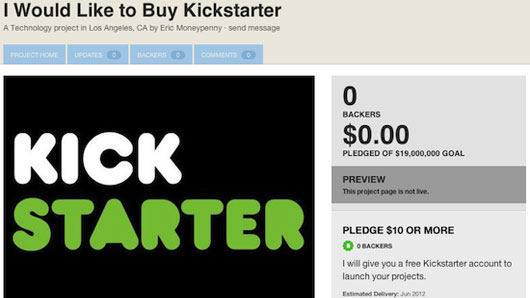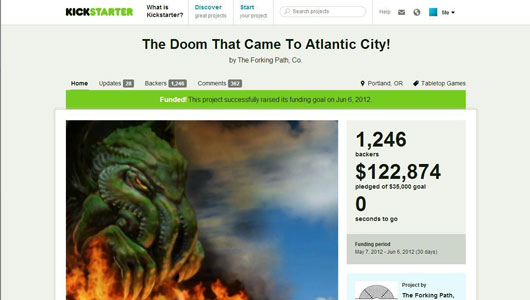Going forward, I plan to write a semi-regular feature article primarily based on Kickstarter which I am going to name “Red Hot Kickstars”. I also plan to get other writers from BRB to submit contributions based on their interactions with Kickstarter and other social or crowd funding platforms. It is mainly to highlight some of the projects that we think will be worthy of your attention, but also to give real world examples of the ups and downs of crowdfunding projects. If I go all out and actually “do some journalisms” then I might even get some quotes from the creators involved too.
Before I embark on this epic-ly heroic, treacherous journey of journalism, I thought it would be a good idea to write two articles to bring everyone up to speed on what interactions I have had with Kickstarter so far and also just to cover some of the crowdfunding basics for the uninitiated.
While I will go into further details of the projects I have backed in my next article, I feel that it is worth pointing out that my views are likely to be heavily influenced by the type of projects I have backed on Kickstarter. So far these have tended to be a small number of videogame projects and a greater number of tabletop gaming projects. I have also discussed with friends their experiences of backing other projects commonly in the Games section, the Technology section and the Comics section of Kickstarter. My sister also successfully crowdfunded her latest album via (the now seemingly defunct) crowdfunding site Pleasefund.us.
The Growth of Crowdfunding
Crowdfunding (AKA social funding) has grown exponentially in the last few years. As far back as 2013, Wikipedia listed the crowdfunding industry to be worth over $5.3 billion worldwide and has continued to rise in popularity since this time. While some people expect a gigantic crash to follow a large scale, high profile failure, there have been enough reasonably large scale failures that this could have happened with, that organisations such as Kickstarter have easily survived. As an ever increasing number of people have successes with crowdfunding it is only likely to continue to grow, even if the rapid growth of recent years begins to cool as crowdfunding sites mature. Every crowdfunding success story makes it increasingly resilient to any potential crash.

Not the Only Show In Town
To settle a few potential bones of contention – I am well aware that they are a number of Social Funding sites available other than Kickstarter. Indiegogo is perhaps one of the most well known in the UK as it was popular prior to UK creators being able to make use of Kickstarter.
I am also aware that there are crowdfunding platforms that offer profit share but they tend to be nowhere near as popular as the likes of Kickstarter and Indiegogo as they remove a large part of the appeal for creators – mainly creative and financial freedom.
There is also a new player emerging with news today of the launch of Fig. Described as the “first-ever funding platform for iii video games” (i.e. the Indie game equivalent of AAA) Fig is a highly curated service with assistance given to developers “through the funding, development and publishing stages.” Which could be a highly attractive unique selling point for videogames in comparison to other platforms. The involvement of Double Fine, who were prominent users of Kickstarter could also play its part. It also offers traditional Kickstarter style rewards in conjunction with investment opportunities. Although note that you first need to be signed up and approved to be an “Accredited Investor” and must pledge a minimum of $1,000.
Not a Pre-order
Many people, even some who have parted with their hard earned cash, seem to misunderstand the nature of backing a project, and in particular, how this is different to making an investment or, particularly in the case of games, making a preorder. With an investment you expect a (usually financial) return, traditionally in the form of rent, appreciation, interest or dividends. All investment comes with an inherent risk, but this risk is a little different when backing a crowdfunding project. You do expect to get something in return from crowdfunding, usually a well defined creative product with a few bonus items but you do not commonly expect to gain a profit. In fact, Kickstarter rules prohibit it; “Project creators keep 100% ownership of their work, and Kickstarter cannot be used to offer equity, financial returns, or to solicit loans.”
The level of guarantee of a return from you backing a project is another common misconception. Crowdfunding sites do not (in any case, to my knowledge) give an absolute guarantee that you will get *anything* in return for backing a project or even carry out any test to ensure that the creator is able to deliver on their promise. Kickstarter’s rules state; “Kickstarter does not guarantee projects or investigate a creator’s ability to complete their project. On Kickstarter, backers (you!) ultimately decide the validity and worthiness of a project by whether they decide to fund it.” I will be the first to admit that I have backed projects on Kickstarter from creators I knew nothing about. I apologise for not doing my due diligence on behalf of us all! More seriously though, for future reference, do not take it as read that just because a project has been backed by thousands of people that anyone has actually checked into the creators. Also worth noting that you can contact any creator before backing the project with any questions you may have.

I Am The Law
When making a preorder with a retailer you have certain rights and assurances afforded to you by law – within the UK most of these would be covered by the Sale of Goods Act 1979 and subsequent revisions, but are likely to be covered by similar legislation in most countries. However, entering into an agreement to back a creative project on Kickstarter is not necessarily or entirely covered by these laws.
The UK’s fairly recently formed Financial Conduct Authority (FCA) states that in regards to UK law, that the type of “Pre-payment or rewards-based crowdfunding” available on Kickstarter is not regulated by the FCA. It is a situation they are aware of, regard as a high risk investment and are monitoring, but it is not something presently covered by their regulations. While not regulated by the FCA, there are some common laws that could apply in the event of a problem, but no one to bring a complaint to. As it stands in the UK, the only recourse a disgruntled project backer would have is standard, private legal proceedings.
European law seems to have a similar stance to that of the UK. The Finnish FSA states “There is currently no comprehensive legislation governing crowdfunding. However, the operating model of crowdfunding may be subject to some valid regulation.”
As with many new creations of the digital age, the law is having to catch up with changes in the way we operate, but there are early signs that this is already becoming a reality, at least in the US.
Doom and Gloom

In June 2015, the American, Federal Trade Commission published its press release on its findings regarding the investigation of a board game named “The Doom That Came To Atlantic City.” (Incidentally, even before this another company, Cryptozoic, came in to save the day, picked up the licence to the game, honoured the pledges made on Kickstarter and then proceeded to sell the game elsewhere. A copy of which can now be played at Loading as it features in our game collection there.) In this case the complaint that the money had been misused was upheld and the defendant ordered to refund his unhappy customers. However, this is where the cautionary tale kicks in.
Lesson 1: Even when you get a financial regulator and the law to agree that you should get your money back there is no guarantee that you will.
The FTC’s settlement order states; “The order imposes a $111,793.71 judgment that will be suspended due to Chevalier’s inability to pay.” In other words, because the defendant, Erik Chevalier had “…spent most of the money on unrelated personal expenses such as rent, moving himself to Oregon, personal equipment, and licenses for a different project.” he now did not have enough money to pay back what was owed.
So, there is also a lesson for dishonest creators; if you are going to spend the money dishonestly, make sure you spend it quickly! (Although it took fourteen months in this case, so no great rush!)
Lesson 2: Kickstarter Always Gets Paid
The Kickstarter campaign for The Doom That Came To Atlantic City raised over $122,000 (which was well above the initial $35,000 the project creators were seeking). You may notice a slight discrepancy between this figure and the amount that Mr Chevalier was ordered to repay. It is said that Kickstarter take 5% commission but the missing sum is nearer to 9%, which leaves almost $5,000 unaccounted for – although I would guess that Mr Chevalier was able to prove that this figure had been spent on legitimate business expenses. That said, there appears to be no allowances made for handling fees for processing any credit card payments. However, the lesson to be learnt here is that even in a case where the FTC have proved that the money needs to be repaid to customers, Kickstarter still retains their fee.
Some would say that is more than fair given they do a similar amount of work whether the campaign is run honestly or nor. Arguably they may well end up doing more work in the case of dishonestly or badly run successful campaigns. However, I can imagine feeling quite jilted if I had paid into a campaign that went so badly the money was ordered to be repaid and I did not even get a refund of the part of the money that was taken by the crowdfunding platform. Worth reiterating that the fee taken is only for putting people in contact with each other via the platform and organisations such as Kickstarter “does not guarantee projects or investigate a creator’s ability to complete their project.”
Future Funding
The crowdfunding ideal is all well and good when everything is working properly, but not so great for those on the receiving end of a dishonest or badly managed campaign. While I do advise and exercise caution it is only due to the desire to preserve this newly found method of funding. As Kickstarter itself states; “Backing a project is more than just pledging funds to a creator. It’s pledging your support to a creative idea that you want to see exist in the world.” Many of the projects that have come from crowdfunding sites would, perhaps, have never made it to market, or even the attention of the public, if it was not for a bunch of awesome people believing in something better and believing in that enough to help fund its very existence.
Larger companies are beginning to abuse crowdfunding platforms, insisting that they are used as a proof of interest in an idea. I would like to see both this practise and a few other aspects policed a little better. It would be preferable that crowdfunding platforms introduced some measures themselves, but failing that it would be reassuring to feel we have a regulatory body that can be called upon if someone is being deliberately corrupt, dishonest or just running a badly managed campaign. Having little or no regulations for an industry that exceeds $6 Billion seems like a recipe for a large-scale disaster. Crowdfunding is an excellent creative enabler. It allows creators a direct line to both customers and finances, while also allowing project backers to feel more involved and valued in the creative process.
In the future someone else might be looking after our interests. For now it is left up to us. I will watch your backed projects if you watch mine.







Michael Barclay
Kickstarter is a scary place. Sure it’s full of successes but it’s full a whole host of horror stories too. There was the horrible incident involving Dimension Drive that was covered on the site a few months back.
http://www.bigredbarrel.com/2015/05/2awesome-studio-and-the-kickstarter-nightmare/
In other interesting and very recent news, some chaps from Double Fine are setting up a new crowdfunding service called Fig. The gist seems to be that, unlike Kickstarter, all backers are treated like actual investors and see a return on that investment when the game starts producing money. As far as I can tell it’s only for video games and also the return on your investment is simply recouping what you initially pledged. At the moment it’s not available to everyone and only accredited investors can back but it should be opened up to the general public at some point.
Still it’s interesting and a massive incentive for people who back early. Rather than just getting a few extra stretch goals you get your money back because you helped pay for the game!!
https://www.fig.co/about